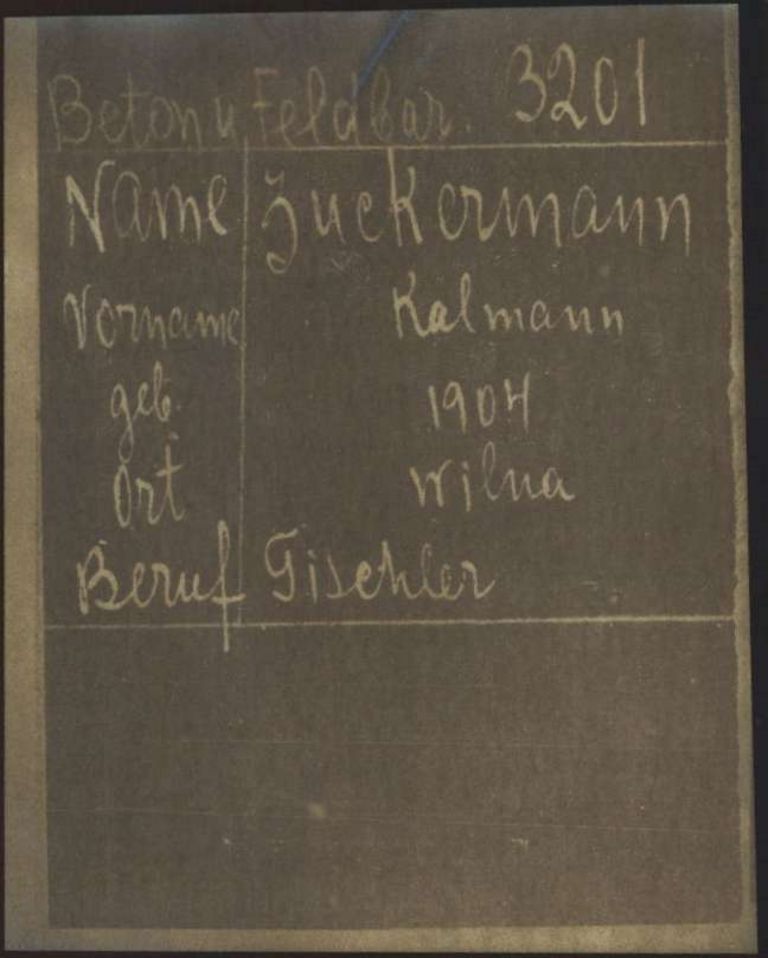Page of
Page/
- Reference
- Intro


This document is a prisoner registration card from Klooga concentration camp in Estonia. These cards, which are only available on microfilm in the Arolsen Archives, are largely structured the same way. The only major differences are on the lower part of the card, where information on labor details, time in the sick bay, and transfer dates or the prisoner’s date of death were noted.
This document is a prisoner registration card from Klooga concentration camp in Estonia. These cards, which are only available on microfilm in the Arolsen Archives, are largely structured the same way. The only major differences are on the lower part of the card, where information on labor details, time in the sick bay, and transfer dates or the prisoner’s date of death were noted.
Questions and answers
-
Where was the document used and who created it?
One of the last concentration camps established by the Germans was Vaivara concentration camp in Estonia. From August 1943, around 9,000 Jewish men and women were deported there from the liquidated ghettos of Kaunas and Vilnius. 2,000 of them were then taken to the Klooga sub-camp, which existed until the Germans withdrew in September 1944. The Jewish men and women in this sub-camp were forced to build signal boxes and field barracks, produce concrete sea mines, pour cement ceiling beams and work in the sawmills of the Organisation Todt, among other things.
Comparing the prisoner registration cards from Klooga concentration camp, it is clear that – with few exceptions – they were all filled out and updated by a single person. The camp clerk in Klooga was a prisoner named Josef Niedermann from Vilnius. In this position, he was responsible for all important clerical work in the concentration camp, and he regularly updated the information about the prisoners in overviews and card files. It was therefore probably also his responsibility to maintain the prisoner registration cards.
- When was the document used?
Klooga concentration camp existed from September 1943 to September 1944. These cards were created for all prisoners who were imprisoned in Klooga until September 1944. A few days before the Soviet Army arrived, prisoners from other sub-camps and labor details who could no longer be “evacuated” to other camps by ship were taken to Klooga. On September 19, 1944, nearly all of the prisoners in Klooga concentration camp were shot in a mass execution; very few managed to escape.
- What was the document used for?
Vaivara concentration camp and its sub-camps such as Klooga – which were often similar in size to the main camp – were established during a time when the economic exploitation of the prisoners was the primary focus. In Klooga, the prisoners worked for the armaments industry in three shifts from 3:00 a.m. until 9:00 p.m., mainly constructing concrete mines and field barracks important to the war effort. To manage the prisoners and their labor, the most important information was recorded on the prisoner registration cards in the camp registry office: personal details such as the prisoners’ names and birthdates, their occupations and the labor details to which they had been assigned. Time spent in the sick bay and transfers – usually to Reval (now Tallinn) – were also noted.
- How common is the document?
The Arolsen Archives have registration cards for most of the around 2,000 prisoners of Klooga concentration camp. These cards are stored on microfilm. With the exception of a few reports from the clinic, these prisoner registration cards are the only documents from this camp that have been preserved in the Arolsen Archives. Karl Kiepfer, who spent three months as a Hauptscharführer (Chief Squad Leader) at Klooga concentration camp, recalled during an interrogation in January 1970 that he had carried out an order from the administrative officer Otto Brenneis, who had demanded that the files be burned. This is why there are so few documents from Klooga concentration camp. It is not clear how the prisoner registration cards survived this action. The original cards are held today in the Eesti Riigiarhiiv, the Estonian National Archives.
- What should be considered when working with the document?
Compared to the inmates in other concentration camps, the prisoners in Klooga were rarely transferred or transported back and forth between camps and external labor details. There was essentially only one major change, on August 19, 1944. For this reason, some of the cards bear the note Ub 19/8 R. This stands for the transport of at least 250 female prisoners from Klooga to Reval (Ub/UB = Überstellung [transfer]; 19/8 = August 19; R=Reval). This group was then transported by ship – probably with several hundred male prisoners from Klooga – from Reval (now Tallinn) to the Stutthof concentration camp near Gdansk. This was an exception, however, because most of the prisoners spent the entire twelve months of the camp’s existence in Klooga itself.
If you have any additional information about this document or any other documents described in the e-Guide, we would appreciate it very much if you could send your feedback to eguide@arolsen-archives.org. The document descriptions are updated regularly – and the best way for us to do this is by incorporating the knowledge you share with us.
Help for documents
About the scan of this document <br> Markings on scan <br> Questions and answers about the document <br> More sample cards <br> Variants of the document



